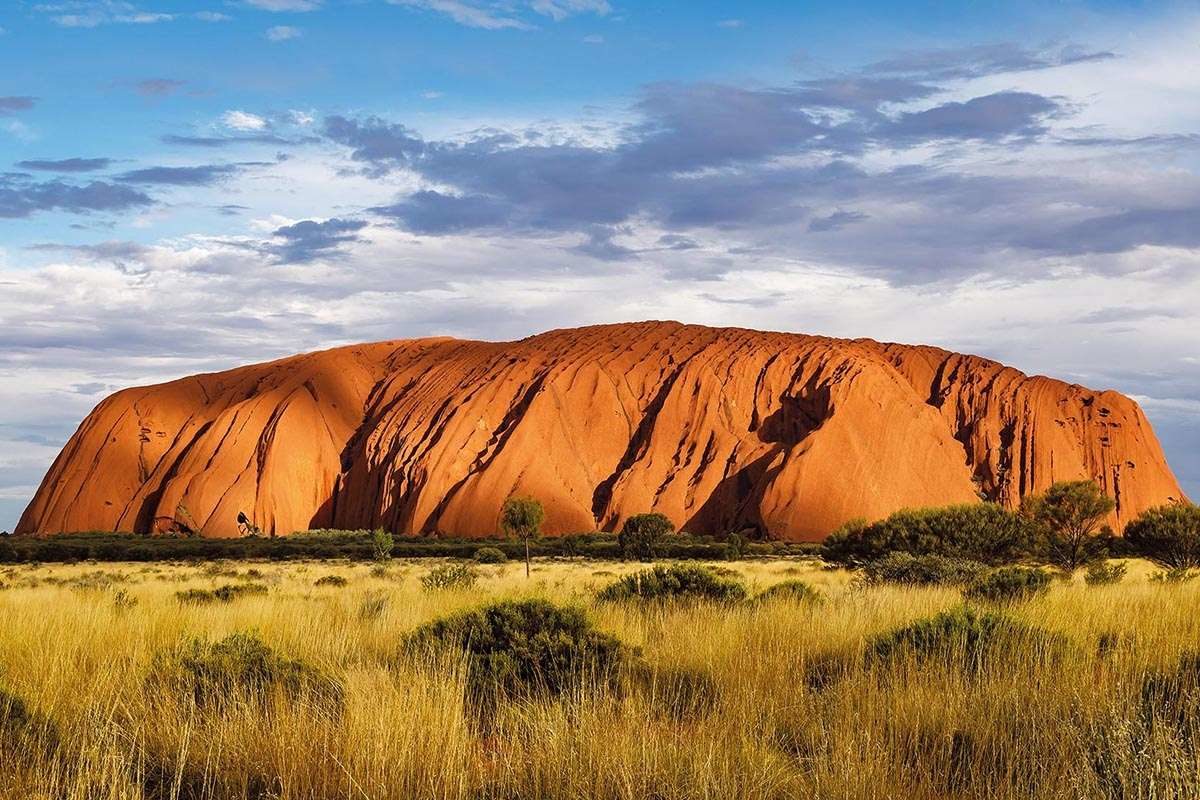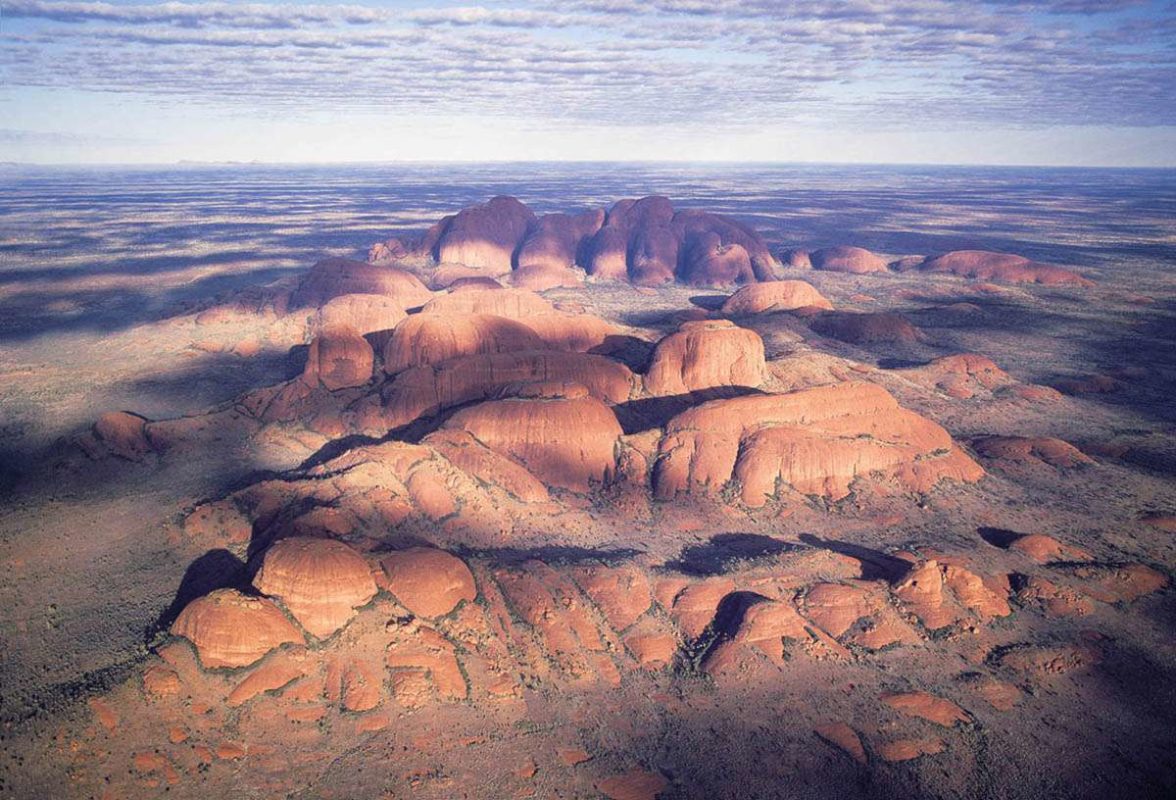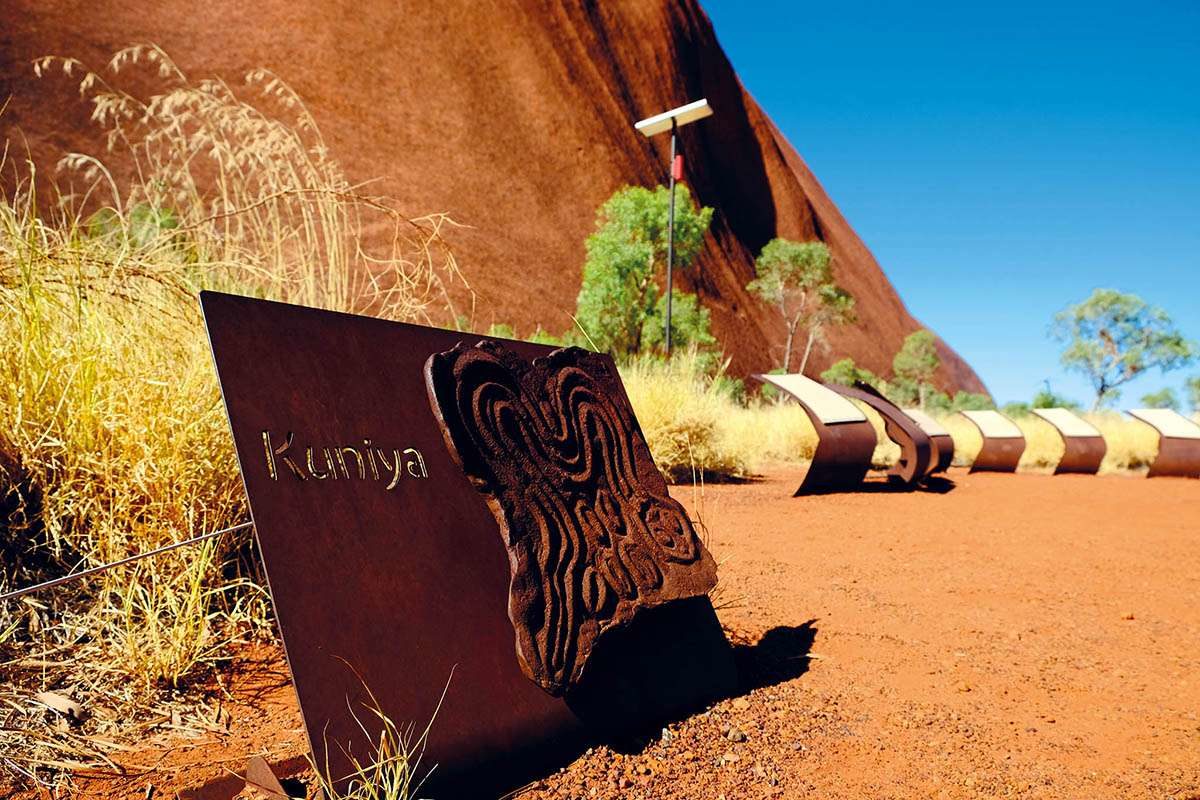
From 26 October 2019, tourists will no longer be able to climb Uluru. Chris Fitch heads to the sacred site to discover what this means for Aboriginal people and visitors alike
By
The name for tourists here is minga,’ says Peter Wilson, his eyes fixated on the faint line of posts running along the rock in front of us, faint specks visible moving alongside them. ‘Minga means “ants”.’
The reference is flawless. Tiny dots scrambling up and down in a distant line – many resorting to quadrupedalism – we could easily be looking at a procession of ants scurrying back and forth from their nest. Even from this distance, their predetermined path is obvious, a grey, jagged line snaking up from the base and out of sight, over the top towards the summit.
Wilson takes a deep sigh, turns to look at me. ‘So, the climb as we know it will be closed on 26 October this year… permanently.’ A beat. ‘Hooray!’ he cries, throwing his head back in a joyous roar of laughter.

The first climb
Uluru should need no introduction, as synonymous with Australia as kangaroos and boomerangs. From above, the enormous sandstone rock, windswept and curvaceous, emerges unnaturally prominently from the flat, arid desert landscape, as though dropped from outer space. Known as ‘Ayers Rock’, after former Chief Secretary Sir Henry Ayers, the name was officially changed to ‘Uluru’ – its name in native language Pitjantjatjara – in 1993. Together with Kata Tjuta, another large rock formation 53 kilometres away (once known as ‘the Olgas’), it now forms the centrepiece of the Northern Territory’s Uluru-Kata Tjuta National Park. The land was officially returned to the Anangu, the traditional Indigenous owners for over 30,000 years, in 1985, before being leased back to the government for the next 99 years.
Despite its rich heritage (Uluru-Kata Tjuta first became a UNESCO World Heritage Site in 1987, for outstanding natural values, and then again in 1994, for outstanding cultural values) for many people, both domestic and international, Uluru is still first and foremost a tourist attraction. Tourism first emerged in the 1950s, when Alice Springs resident Len Tuit began organising tours along smooth new roads – improved as part of the war effort – into the mysterious and romantic ‘red centre’. History records that 2,296 tourists made the long, hot, dusty journey out here in 1958, their accommodation at the time were tents at the base of the rock. Uluru is now visited by around 300,000 tourists annually, with visitors drawn from all around the globe – despite Uluru being 442 kilometres from Alice Springs, the nearest urban hub, and over 1,416 kilometres from Darwin, the capital of the Northern Territory.
In 1873, when William Christie Gosse first spotted Uluru, he described it: ‘certainly the most wonderful natural feature I have ever seen’. He also became the first European to scramble up Uluru’s rust red surface and stand on the summit, 348 metres above the ground (roughly three-and-a-half-Big Bens). Since then, hundreds of thousands, if not millions, have followed in his footsteps, traipsing up and down a route carved out on one of the rock’s many faces. For many of these tourists, visiting Uluru/Ayers Rock without climbing it would be unthinkable. But for the roughly 2,500 Anangu residents, admiring the rock as an impressive and dominating feature is one thing. Actively walking over the surface is far more disrespectful.

A culture of safety
Each morning, an Uluru-Kata Tjuta National Park ranger leads a free walk around the base of the rock. Halfway round, today’s guide, Linda, pauses for a stern declaration. ‘Anangu and Parks Australia request: please don’t climb,’ she tells us. ‘There are several reasons for this, including safety reasons, cultural reasons, and environmental impacts.’ For years, this has been the official position: the climb remains open, but tourists are heavily discouraged from undertaking it.
Safety is certainly the key message delivered to the group today, with Linda emphasising the many people who have been severely injured and even killed by the endeavour. At least 35 people are known to have lost their lives as a result of climbing Uluru in the 50 years since the guiding chain was installed, some from falling off the rock, but most deaths caused by heart attacks and strokes brought on by the exhaustion of the climb – meaning the real figure is probably even higher.
Safety precautions are now a regular feature of the park rangers’ duties, with temperature, wind speeds, weather forecasts and other metrics checked five times daily. When these numbers fall outside the safe zone, due perhaps to strong winds, or high temperatures, the rangers are legally bound to shut the climb, something that is now a fairly frequent occurrence. ‘We are simply the messengers, don’t shoot the messenger,’ pleads Linda, putting her hands up in mock surrender. ‘I’m just doing my job.’
Could the climb be made safer? Peter Wilson, Anangu guide for the tour company SEIT, scoffs at the idea. ‘Would you put safety precautions here, to stop people dying?’ he demands. ‘Have you come here to see harnesses and chains put on a World Heritage-listed park? People come here to see the natural beauty.’
That natural beauty is being worsened by severe environmental degradation caused by tourists. For starters, the top of Uluru has no facilities to accommodate climbers, such as toilets or waste disposal. ‘But people discard everything up there: camera batteries, drink bottles, food wrappers, children’s nappies, ladies’ sanitary products,’ explains Linda. ‘They urinate and defecate. When it rains, all of that washes down into the waterholes, rendering them completely polluted and useless for everyone and everything.’ Of the wildlife affected by the torrents of contaminated water that pour off the rock during times of high rainfall, frogs are particularly suffering, killed by the bacteria that thrive in the rancid pools at the base of the rock.
Perhaps the installation of bins and toilets could reduce the impact of waste and general tourist debris left by visitors. Perhaps the climb could – Peter’s concerns about aesthetics aside – be made safer. But behind these surface concerns lies a deeper cultural tension regarding the sacred nature of Uluru that has been bubbling away beneath the surface for decades, and only recently reached a decisive conclusion.

Making marks
For thousands of years, the Anangu have lived by strict laws known as Tjukurpa, that determine the relationships between people, plants, animals, and the land. These laws are reinforced by ancient stories with strong moral messages about the right way to live your life, and how to protect the land upon which your survival depends. And these stories are directly linked to specific parts of Uluru, giving them immense sacred importance.
‘Pitjantjatjara is a verbal language, there’s no written language,’ explains Steven Baldwin, manager of park operations and visitor services at Uluru-Kata Tjuta National Park. ‘No books, no records. So in terms of passing on creation stories from generation to generation, and their history and their culture, the Anangu rely on key locations and features, either on the land or on the rock itself, as a trigger. Markings on the rock, be they indents or markings, actually play a part in these stories.’
For example, many grooves and cracks in the rock around the famous Mutitjulu waterhole can be explained by the legendary conflict between Kuniya, the womb python woman, and Liru, the poisonous snake man, such as when the rock was hit by flying spears. Anangu legend also tells of Lungkata, a greedy and dishonest blue-tongue lizard, whose efforts to steal and eat an emu failed because of the pieces of meat he dropped as he fled, now visible as fallen rocks on the southwest side of Uluru. And probably the rock’s most prominent creation story is that of the Mala men, attacked and killed by Kurpany the devil-dog, whose footprints are still visible on the northeast face.
These are just a sample selection of stories, all of which contain valuable moral lessons, such as not to steal, or to always watch out for danger, that have ensured Anangu survival in this hospitable landscape for millennia. There are many more stories that can never be shared, even with other members of Anangu communities, in accordance with Tjukurpa. Photos of these markings are never allowed to be taken, hence the reason that most pictures of Uluru show only a smooth surface, one of the few sections of rock that bear no significant sacred markings.
‘The whole rock is a myriad of locations which are incredibly important in Anangu culture,’ explains Baldwin. ‘So it is certainly completely inappropriate to see thousands and thousands of people climbing up at the top.’ As if to add insult to injury, the specific path tourists use to reach the summit crosses right over the route supposedly used to reach a ceremony site in one of the creation stories, making that area particularly sensitive.

Beyond the climb
In November 2017, the jointly-managed (Aboriginal and non-Aboriginal) Uluru-Kata Tjuta National Park Board made the decision to close the climb, once and for all. It agreed that the specific criteria that needed to be fulfilled for the climb to be closed had been achieved, and, as such, it would be shut entirely from 26 October 2019 (the exact date means it will coincide with the 24th anniversary of the official handback). These criteria were that there had been consultations with the local tourism industry for at least 18 months, that the number of tourists at Uluru undertaking the climb had fallen below 15 per cent, and that there were sufficient alternative activities for tourists to participate in, instead of climbing the rock.
This is where Parks Australia now appears to hope the future lies for Uluru-Kata Tjuta. Artistic expressions such as Bruce Munro’s Field of Light installation, incorporating 50,000 stems coming to life as the sun slips over the horizon, have been wildly popular. Future events, such as a concert by Opera Australia, aim to draw new and recurring visitors to the desert, while the park now hosts regular astronomy classes to learn both Western and Anangu star-gazing stories. There’s even a luxury spa for those who wish to spend their time in the desert being pampered from head to toe. Finally, it is now possible to drive, cycle, Segway, camel ride, skydive, even take a helicopter ride around the park, with Uluru as your picturesque backdrop.
‘There’s been a strong push towards other activities, showing people you don’t have to conquer or climb onto Uluru to enjoy it,’ says Baldwin. ‘We honestly don’t think there will be a significant drop off.’ He points out that recent park visitor numbers have been at their highest since the aftermath of the Sydney Olympics, even as the percentage of climbers fell below that 15 per cent threshold.
Not that these alternatives are uncontroversial. ‘It’s not insignificant that the climb is closing, but at the same time, the helicopters are really just a different version of it,’ argues Dr Jana-Axinja Paschen, research fellow at the University of Melbourne, whose work has included understanding the cultural geographies of Central Australia. ‘Flying a helicopter over Uluru, it’s all about getting that position of overview, again, rather than really being there. I think just closing the climb is not enough of a decolonising gesture.’
She emphasises that ‘relevant cultural information and education’ is key to improving and modernising Uluru-Kata Tjuta as a tourist destination. ‘It would go beyond just that site,’ she insists. ‘I feel potential for better education on Aboriginal culture in general, what it means to look after country, and what the spirituality of country means.’
Walking around the Uluru cultural centre, opened in 1995, includes a deep dive into Anangu life, including creation stories and Pitjantjatjara language lessons, as well as the opportunity to observe Anangu artists working on their latest creations. It’s evidence that suggests Uluru is indeed capable of moving away from being all about physical challenges and adrenaline highs, and towards being a meaningful place of cultural learning.
It also contains something akin to a visitors book. Except, this is actually an ‘I did not climb Uluru’ register, full of hundreds of comments from people proudly declaring they didn’t climb, instead praising the virtues of the base walk, and similar experiences. Certainly, my own cycle around UIuru was significantly enhanced by information boards revealing the creation stories behind various markings on the way round – perhaps an example of how these new activities might be able to live hand-in-hand with the more educational aspects of the experience.
Either way, by the end of October, every single visitor to Uluru-Kata Tjuta will qualify for a spot in the no-climbing register, whether they like it or not. Then perhaps the Anangu will need an entirely new word to describe tourists, their resemblance to ants consigned to the history books forever.

Uluru’s geology
Up close, the foreboding nature of Uluru is truly apparent, the arkose (or ‘feldspathic’) sandstone sides intimidatingly steep, ascending towards the sky and out of sight. The surface appears flaky, almost like bark, although with a rust red veneer that gives it a metallic hue. It’s easy to see why Uluru plays such a prominent role in Anangu creation stories; it’s almost impossible not to start seeing shapes of animals or faces in the rock’s evocative curves, deep caves, gashes, and weather-beaten pitt holes.
Thick sedimentary layers run perpendicular to the ground, like a cliff on its side. In many ways, this is an accurate description; the entire rock is just a small visible chunk of the world’s largest known monolith, extending over three miles further underground. Uluru as we know it is simply a minor section that was tilted upwards by immense geological forces 400 million years ago, before being steadily eroded down to the current height.
The grey scar that marks the climbing route is clearly visible, glimmering in the midday sunshine, reflecting the memory of millions of footsteps. How long until the effect of hundreds of tourists’ feet scraping against it on a daily basis, year-after-year, eventually diminishes, and the line once again takes on the familiar red colour that enables it to blend in with the rest of the rock? Steven Baldwin talks confidently about time being the best healer, that it will be only a few years before it disappears, but it may not be anything like so rapid.
‘The clear whitish path on the rock from the climb path is caused by climbers wearing away the outermost oxidation surface of the rock,’ explains Carl Spandler, an associate professor at the College of Science & Engineering, Economic Geology Research Centre, James Cook University. ‘Even though this is probably only millimetres thick, it is likely to take a very long time for the oxidation colour to return to the path, and to make the path blend back in with the surrounding rock. In the dry climate of central Australia, and even considering the occasional rain event, I would estimate this will take many decades – possibly centuries – for the path to fade back to the natural colour.’
Annette George, an associate professor at the School of Earth Sciences, University of Western Australia, concurs, adding that while ‘oxidation of the foot-worn surfaces will presumably proceed more quickly without foot traffic,’ she points out it took millions of years for Uluru’s surface to weather to the current state, so even if the recovery is especially fast, we still could be waiting quite a long time.




